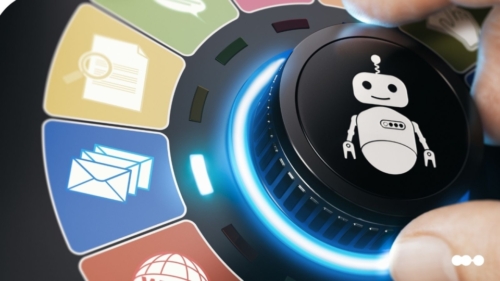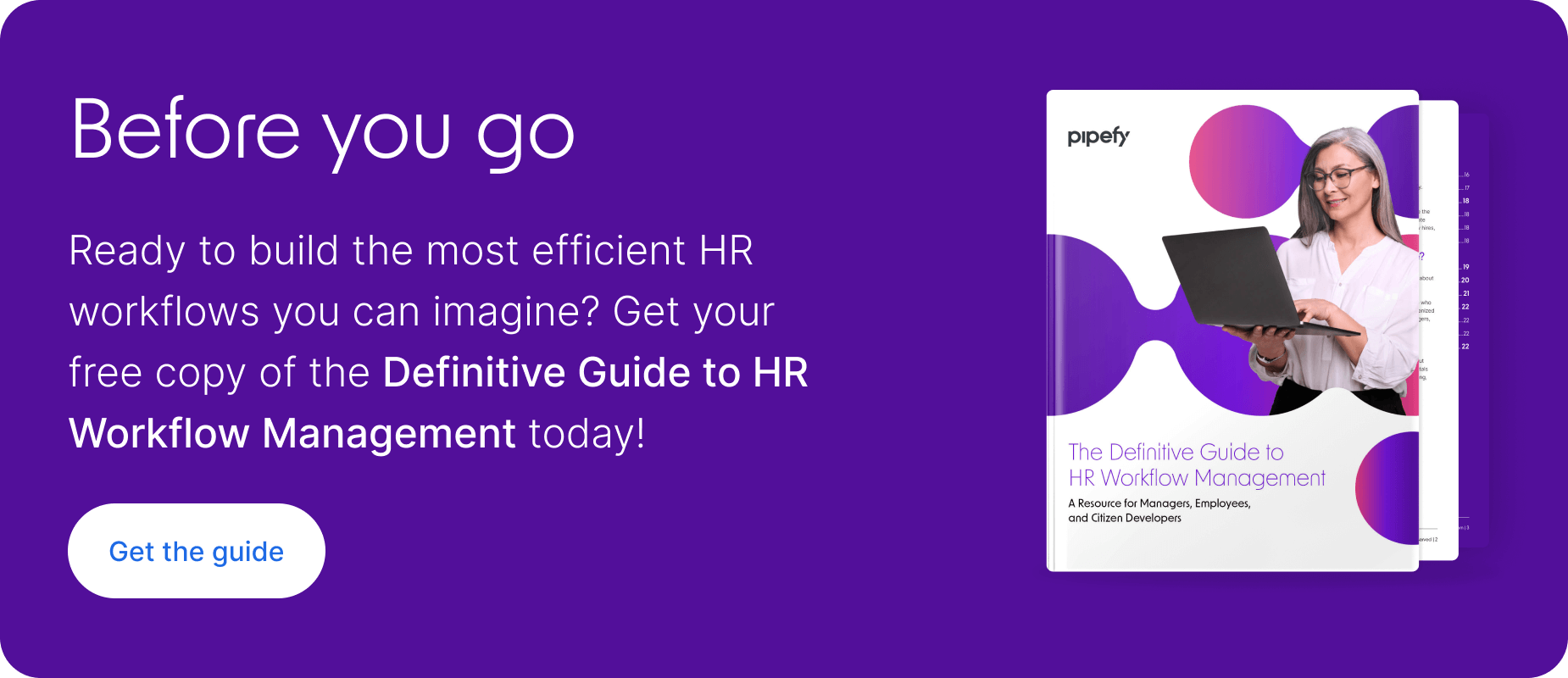
If your HR and People Ops teams are taking questions from employees via email, over the phone, over messaging applications, or at the water cooler, it might be time to consider a more centralized and standardized solution like an employee helpdesk.
In this blog post, we’ll share everything you need to know about employee helpdesk software, including why they’re beneficial for HR and People Ops teams and a must-have for companies.
Definitive Guide to HR Workflow ManagementDownload now
What is an employee helpdesk?
The term ‘employee helpdesk‘ (also known as an HR helpdesk) refers to ticket or request management software that centralizes employee questions or requests, streamlines responses or resolutions, and adds a layer of visibility between request and resolution.
An employee helpdesk provides employees with a clear, standardized, and accessible way to submit questions or requests about payroll, benefits, timekeeping, leaves of absence, or any other HR-related issue.
For HR and People Ops teams, an internal helpdesk organizes those questions or requests and automates manual and time-consuming administrative work. This ensures all tickets are directed to the appropriate team and resolved in a timely, accurate, and transparent manner, so leaders have insight into the productivity and efficiency of HR processes.
What are the essential components of an employee helpdesk?
To create an employee helpdesk that operates like a well-oiled machine, look for a software solution that:
- Offers single sign on for employee convenience
- Automates ticket assignment, ensuring tickets are directed to the team or team member who can resolve them
- Gives employees more than one way to submit a ticket (chat, email, portal) to meet their needs
- offer 24/7 accessibility
- Include an internal knowledge base that offers employees quick access to commonly requested documents, policies, and forms
- Give managers, HR business partners, and People Ops teams the option to open a ticket on behalf of someone else
- Tracks metrics — like first contact resolution, days to resolution, and volume by topic or assignment group — to gain valuable insights into process challenges and improvement opportunities
- Automatically notifies employees when their ticket has been updated or closed
What are the advantages of having an employee helpdesk?
The key benefit of having an internal helpdesk is the ability to automate ticket creation and management. This offers a myriad of benefits for employers, HR and People Ops teams, and employees. For example, employee helpdesk software:
- Prevents employee requests from being forgotten or ignored
- Gives the requestor insight into progress on their ticket as it moves through stages of resolution
- Allows for communication between HR business partners and employees who may work at different times of day
- Allows businesses to track trends, like a rise in PTO accrual issues or timekeeping errors, and respond accordingly
- Leads to better, more strategic data-driven policy and process decisions
- Improves overall employee satisfaction by streamlining access to the help they need
What kinds of processes can be managed with a helpdesk?
Practically every type of HR process can benefit from an employee helpdesk. That’s because helpdesk software reduces time to resolution, eliminates redundancies, and helps teams avoid errors. Some of the most common HR processes that teams manage with internal helpdesk software include:
- Request management
- PTO and sick leave
- Benefits
- Performance management
- Equipment requests
- Onboarding
- Offboarding
How to set up an employee helpdesk
Whether you’re feeling overwhelmed by the prospect of setting up an internal helpdesk for the first time or just looking for a framework to inspire your own, check out this step-by-step guide to get started.
Step 1: Decide which requests you will accept
Employee helpdesks are meant to help organize and help HR teams manage requests. But that can quickly become unmanageable if the internal helpdesk isn’t designed with parameters that define the scope of requests and guide employees.
For example, if the helpdesk inquiries will go to your HR team, perhaps you will accept tickets about payroll or timekeeping errors, but you won’t accept requests about HRIS access or equipment purchases. Those types of requests might be better suited for IT or procurement teams and should go through a different process.
Step 2: Choose the right tool
Once you have a better understanding of how you’ll use your helpdesk, you can begin exploring tools to build and automate your helpdesk. Things to consider include capabilities, customer reviews, cost, and customization.
Step 3: Create your forms
Then, you’ll create your request intake forms. Identify what information you’ll need, at a minimum, for each type of request you’ll accept. For example, you might develop a form specific to employee education or development requests about your Learning Management System (LMS) with fields like “Course Name” and “Issue.”
Step 4: Establish a priority system for the tickets
Next, decide how tickets will be assigned a priority level as they come in. Will tickets that are related to payroll take priority over tickets that aren’t? When you use an automated system, you can assign priority based on ticket type and in some cases, even keywords.
Step 5: Define KPIs to track key results
Finally, define the metrics that are important to your team to measure productivity, alignment with overall business goals, and helpdesk process performance. For example, tickets submitted without a defined ticket type, average request closure time, employee satisfaction with request resolution, and more.
Measuring or tracking performance metrics can be manual and tedious work. But with helpdesk software and built-in dashboard that can track visualize key metrics and generate process reports, easily access the metrics that are most meaningful to you.
Tips to improve your employee helpdesk
Once your employee helpdesk is up and running, it’s important to consider how to continuously improve the solution to best meet the needs of your employees and requesters.
Create an automated self-service portal
Some requests may not require human intervention to be resolved. With a self-service portal, make it easier for employees to find the answers to their questions easily and without delay. Take that one step further with automation to reduce the number of cases that need to be worked by a member of your team.
Self-service automation not only redirects employees to the information, teams, or processes that they actually need. It also improves the accuracy of ticket assignment by automating the request intake and assessment process.
Build an internal knowledge base
A centralized internal knowledge base gives your employees access to policies, procedures, and other company or employee information.
Collect and implement employee feedback
Companies seek customer feedback to learn how to improve their products or services and build better customer experiences. The same applies to HR and People Ops teams.
Whether it’s a feedback survey after every interaction or request resolution or a quarterly check-ins, giving employees an opportunity to share feedback leads to a better understanding of recent experiences and internal helpdesk successes and pain points.
5 reasons why employee helpdesks are a must-have
As more companies continue to adopt remote-first or hybrid work models, the need for employee helpdesk software has evolved from a nice-to-have to must-have. The efficiencies in communication and collaboration it offers across the organization is necessary to keeping employees informed and HR and People Ops teams productive. Here’s how:
1. Reduces SLAs
helpdesk software helps you resolve requests faster because it prevents issues like missing information or gaps in communication. helpdesk software also allows HR teams to set deadlines and categorize requests based on priority so that urgent requests are handled first.
2. Centralizes requests
helpdesk software centralizes requests in a single place. This makes it easier to see, organize, prioritize, and delegate requests and tasks.
3. Improves employee experiences
By allowing employees to track the status of their request or automating notifications that provide clear updates on the status of their requests, employees are more likely to be satisfied with the overall experience.
4. Automates and standardizes manual, time-consuming processes
This ensures all employees have a consistent and predictable experience. It also means HR and People Ops teams are bogged down with manual or time-consuming administrative tasks, like chasing down missing information or alerting requesters.
5. Provides data-driven insights
Gain visibility into the productivity of your HR department, as well as the most common issues impacting employee engagement, productivity, and retention.
Create a human-centered HR helpdesk with Pipefy
Automate and streamline employee requests without losing the personal touch that your employees have to come to expect. Reduce time to resolution, improve employee experiences, and reduce manual work for HR and People Ops teams with a single tool.










